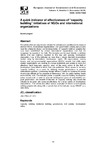A quick indicator of effectiveness of “capacity building” initiatives of NGOs and international organizations

View/
Use this link to cite
http://hdl.handle.net/2183/23397Collections
Metadata
Show full item recordTitle
A quick indicator of effectiveness of “capacity building” initiatives of NGOs and international organizationsAuthor(s)
Date
2015Citation
Lempert, D. (2015). A quick indicator of effectiveness of “capacity building” initiatives of NGOs and international organizations. European Journal of Government and Economics, 4(2), 155-196. https://doi.org/10.17979/ejge.2015.4.2.4312
Abstract
[Abstract] The article offers an easy-to-use indicator for scholars and practitioners to measure whether NGOs, international organizations, and government policies and projects meet the criteria for design and implementation of “capacity building” projects that have been established by various international organizations and that are recognized by experts in the field. The indicator can be used directly to address failures that are routinely reported in this key and growing development intervention. Use of this indicator on more than a dozen standard interventions funded today by international development banks, UN organizations, country donors, and non-governmental organizations (NGOs) reveals that while many smaller organizations are working to change institutions and society in ways that effectively build long-term capacity, most of the major actors in the field of development have failed to follow their own guidelines. Many appear to be using “capacity building” as a cover for lobbying foreign governments to promote international agendas (“purchasing foreign officials”) and/or to increase the power of particular officials at the expense of democracy, with the public lacking simple accountability tools. The indicator points to specific areas for holding development actors accountable in order to promote development goals of sustainability and good governance. The breadth of the field of “capacity building” also allows this indicator to be used, with some modifications, for a large variety of development interventions. This article also offers several examples of where current capacity building projects fail, along with a sample test of the indicator using UNCDF as a case study.
Keywords
Capacity building
Institution building
Governance
Civil society
Development policy
Institution building
Governance
Civil society
Development policy
Editor version
Rights
Atribución 4.0 España
ISSN
2254-7088






